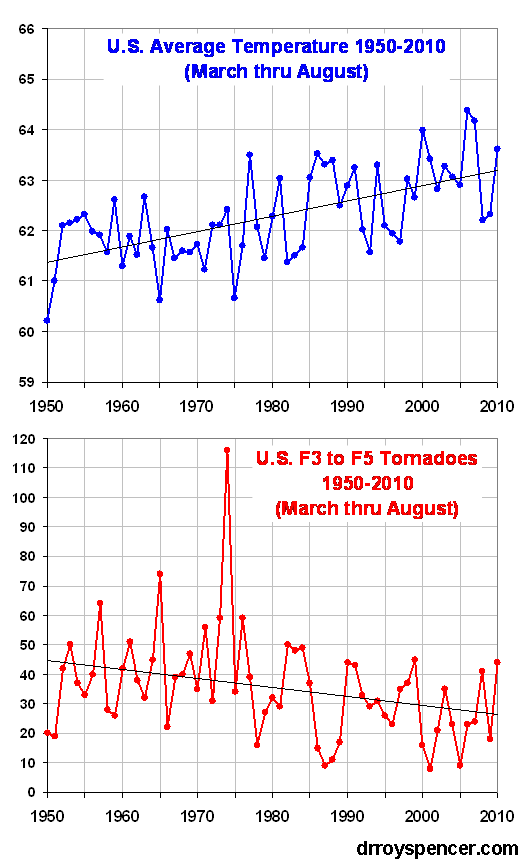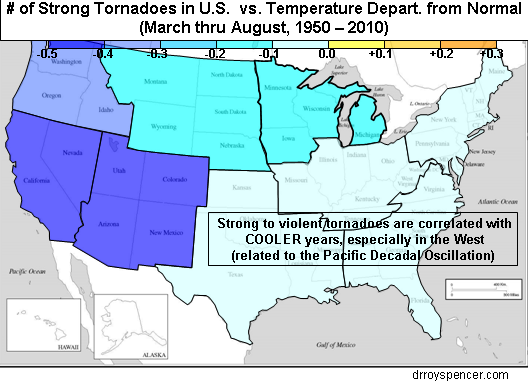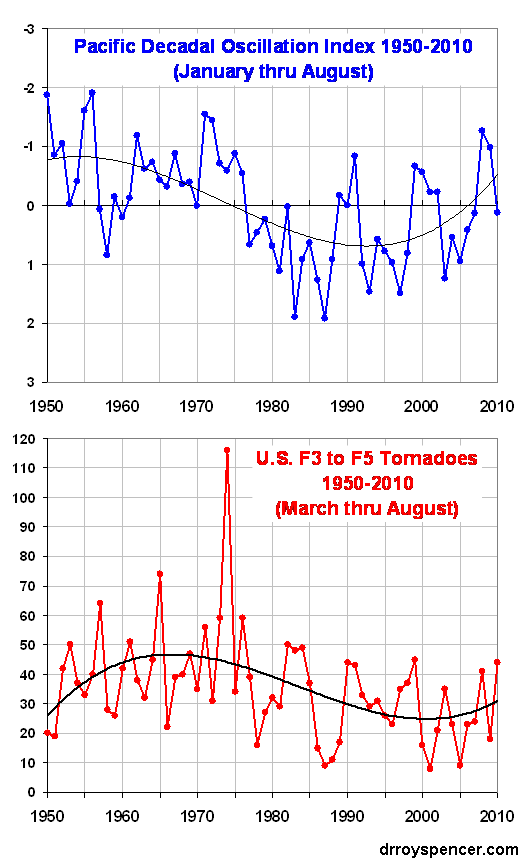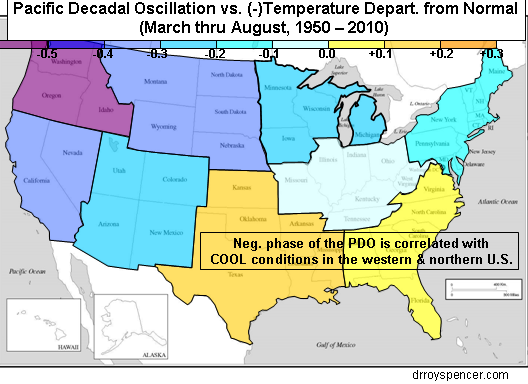This is a continuation of the theme of my last 2 blog posts, dealing with the fact that a greater number of strong to violent tornadoes occur in unusually COOL years, not warm years. As a quick review, the following plot clearly shows this:
This refutes the claim of a few of the global-warming-causes-everything pundits who assume that more tornadoes MUST be Gaia’s way of punishing us for providing her with more plant food (carbon dioxide).
There are 2 main reasons why stronger tornadoes are usually associated with unseasonably cool conditions, and why there has been a decrease in strong tornadoes during a period of average warming:
1) The missing ingredient for tornado formation is not a lack of warm moist air, but a lack of synoptic (large) scale wind shear.
2) At least until recently, the positive phase of the Pacific Decadal Oscillation (PDO) which has predominated since the late 1970’s has suppressed strong tornado activity.
Let’s look at these two issues.
THE MISSING INGREDIENT: WHY 99% OF THUNDERSTORMS DO NOT PRODUCE TORNADOES
I’ve been trying to think of why some might assume a warmer climate would produce more tornadoes, and I suspect the main reason is that tornadoes are produced by thunderstorms, and thunderstorms require warm, moist air for fuel. Ergo, warming should lead to more tornadoes.
But even here in the U.S., which is Tornado Central for the world, 99 out of 100 thunderstorms do NOT produce tornadoes. Why is this?
The missing ingredient is wind shear, specifically an increase in wind speed with height, and a change in wind direction with height.
So what causes this type of wind shear? It occurs in advance of low pressure areas that form along the boundary between warm and cool air masses. So, anything that increases the frequency of these conditions could lead to more tornadoes.
The classic tornado situation involves a longwave low pressure trough over the western U.S., caused by an unusually cool atmosphere in the lowest 5-10 miles of the atmosphere. This has remained true for this year’s enhanced tornado activity. I suspect the persisting mountain snowpack from a very snowy winter has played a role in this.
The following plot of the U.S. shows correlation between the annual number of strong (F3) to violent (F5) warm-season (March through August) tornadoes and regional temperature departures from normal.
First, we see in ALL regions a negative correlation between temperature and the total number of strong to violent tornadoes in the U.S.
This is basically the regional breakdown of the U.S.-average relationship shown in the first plot above, which demonstrates that the increased frequency of strong tornadoes with cooler, not warmer, temperatures. This is no doubt an indirect effect, mirroring the more frequent intrusion of unseasonably cool air masses, which cause the wind shear conditions more conducive to tornado formation.
Secondly, we see that the relationship is the strongest over the western U.S. This pattern is consistent with a longwave low pressure trough over the western U.S., which favors more tornado formation for the reasons outlined above.
So, the next question is, what favors unseasonably cool weather over the West during tornado season? This is where the Pacific Decadal Oscillation (PDO) comes in.
THE TORNADO-PDO CONNECTION
The following plot shows that the positive phase of the PDO, which predominated roughly from the late 1970s up until just a few years ago, was also a period of depressed strong tornado activity in the U.S. Conversely, more strong tornadoes seem to be associated with the negative phase of the PDO.
The reason why this is the case appears to be that the negative phase of the PDO also favors longwave low pressure troughs over the U.S. The following regional correlation plot between the negative of the PDO and temperature shows this quite clearly, with a very cool West and somewhat warm South and Southeast:
Of course, the negative PDO/more tornadoes connection will not necessarily hold every year, just as the La Nina/more hurricanes connection does not hold every year.
But the major point here is that it is NOT the lack of warm air that inhibits tornado formation during tornado season…it is the lack of sufficient wind shear to cause thunderstorms to rotate. And it is the persistence of unseasonably cool air, over most of the U.S., that produces these wind shear conditions.

 Home/Blog
Home/Blog








Konular mükemmel olduğu gibi site teması da içeriğe müthiş uyum sağlamış. Tebrikler
Ankara Web Tasarım Ajansı sayesinde profesyonel web tasarım çözümlerinden faydalanmak istemez misiniz? Dijital ortamda fark yaratan web tasarım hizmetleri sayesinde siz de doğru bir seçim yapın. Üstelik iş birliği yapacağınız web tasarımcı tarafından sunulan profesyonel çözümlerle ihtiyaçlarınızı karşılayın. Peki, Ankara’da profesyonel web tasarım hizmeti almak istediğinizde sizi bekleyen çözümler neler?
Ankara Kurumsal web tasarım hizmetleri sayesinde tercih edeceğiniz web sitesi tasarımının markanızı yansıtmasını istemez misiniz? Kullanışlılığı ön planda tutarken aynı zamanda yüksek performans sağlayacak olan kurumsal web sitesi tasarımlarını hemen tercih edin. Marka bilinirliğinizi arttıracak, tüketici ile aranızdaki bağı güçlendirecek ve size özel bir yaklaşım elde etmenizi sağlayacak çözümlere ulaşabilirsiniz. İşte bize başvurarak alacağınız hizmetlerin bütün detayları!
Ankara Profesyonel Web Tasarım hizmetlerinden yararlanmak istiyor ama kalite odaklı bir çözüme ulaşmanın da yollarını mı arıyorsunuz? O halde size en uygun seçeneklerin neler olacağını titiz bir şekilde değerlendirmenin tam zamanı. Ankara’nın en iyi web tasarım hizmetlerini tercih ederken aynı zamanda kalite odaklılığı da elde edebileceksiniz. Birbirinden özel çözümler ve çok daha fazlası için size neler sunduğumuza bir göz atmalısınız.